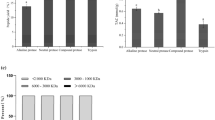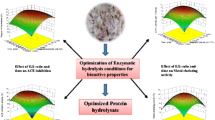Abstract
Squid protein hydrolysates (SPH) were prepared from the Indian squid Loligo duvauceli using papain. Response surface methodology (RSM) was used for optimization of hydrolysis conditions, including temperature, time, and the enzyme-substrate ratio using DPPH radical scavenging activity as a response. The amino acid composition of SPH was compared with raw squid muscle. In vitro antioxidant activities were evaluated based on reducing power, metal chelation, ABTS, hydroxyl radical, and superoxide anion radical scavenging assays. SPH exhibited good ABTS radical scavenging activities of 96.50±0.90%, superoxide anion radical scavenging activities of 96.4±0.89%, reducing powers of 0.71±0.02, moderate hydroxyl radical scavenging activities of 64.03±2.11%, and metal chelating activities of 52.04±1.02%. In vivo antioxidant activities determined using a sardine minced model system showed 42% reduction in formation of secondary oxidative products as thiobarbituric acid reactive substances (TBARS), almost equivalent to reduction by ascorbic acid of 41.42% at 400 ppm.
Similar content being viewed by others
References
Harnedy PA, Fitzgerald RJ. Bioactive peptides from marine processing waste and shellfish: A review. J. Funct. Foods 4: 6–24 (2012)
Kim SK, Wijesekara I. Development and biological activities of marine derived bioactive peptides: A review. J. Funct. Foods 2: 1–9 (2010)
Kris-Etherton PM, Hecker KD, Bonanome A, Coval SM, Binkoski AE, Hilpert KF. Bioactive compounds in foods: Their role in the prevention of cardiovascular disease and cancer. Am. J. Med. 113: 71–88 (2002)
Fang X, Xie N, Chen X, Yu H, Chen J. Optimization of antioxidant hydrolysate production from flying squid muscle protein using response surface methodology. Food Bioprod. Process. 90: 676–682 (2012)
CMFRI. CMFRI Annual Report 2014-2015. Central Marine Fisheries Research Institute, Kochi, India (2015)
Rajapakse N, Mendis E, Byun HG, Kim SK. Purification and in vitro antioxidative effects of giant squid muscle peptides on free radical-mediated oxidative systems. J. Nutr. Biochem. 16: 562–569 (2005)
Yen GC, Wu JY. Antioxidant and radical scavenging properties of extract from Ganodermatsugae. Food Chem. 65: 375–379 (1999)
Ishida Y, Fujiit T, Asai K. New detection and separation method for amino acids by high performance liquid chromatography. J. Chromatogr. A. 204: 143–148 (1981)
Oyaiza M. Studies on products of browning reaction: Antioxidative activity of products of browning reaction prepared from glucosamine. J. Nutr. 44: 307–315 (1986)
Binsan W, Benjakul S, Visessanguan W, Roytrakul S, Tanaka M, Kishimura H. Antioxidative activity of Mungoong, an extract paste, from the cephalothorax of white shrimp (Litopenaeusvannamei). Food Chem. 106: 185–193 (2008)
Decker EA, Welch B. Role of ferritin as a lipid oxidation catalyst in muscle food. J. Agr. Food Chem. 38: 674–677 (1990)
Smirnoff N, Cumbes QJ. Hydroxyl radical scavenging activity of compatible solutes. Phytochemistry 28: 1057–1060 (1989)
Liu F, Ooi VEC, Chang ST. Free radical scavenging activity of mushroom polysaccharide extracts. Life Sci. 60: 763–771 (1997)
Raghavan S, Hultin HO. Oxidative stability of a cod-canola oil model system: Effect of order addition of tocopherol and canola oil to washed, minced cod muscle. J. Aquat. Food Prod. T. 158: 37–45 (2006)
Peng X, Xiong YL, Kong B. Antioxidant activity of peptide fractions from whey protein hydrolysates as measured by electron spin resonance. Food Chem. 113: 196–201 (2009)
Muralidhar RV, Chirumamila RR, Marchant R, Nigam P. A response surface approach for the comparison of lipase production by Candida cylindracea using two different carbon sources. Biochem. Eng. J. 9: 17–23 (2001)
Shao P, Jiang ST, Ying YJ. Distillation for recovery of tocopherol from rapeseed oil deodorizer distillate using response surface and artificial neural network models. Food Bioprod. Process. 85: 85–92 (2007)
Buttle DJ, Mort JS. Cysteine proteases. pp. 589-592. In: Encyclopaedia of Biological Chemistry. Lennarz WJ, Lane MD (eds). Academic Press, Cambridge, MA, USA (2013)
Barkia A, Bougatef A, Khaled HB, Nasri M. Antioxidant activities of sardinelle heads and/or viscera protein hydrolysates prepared by enzymatic treatment. J. Food Biochem. 34: 303–320 (2010)
Bougatef A, Hajji M, Balti R, Lassoued I, Triki-Ellouz Y, Nasri M. Antioxidant and free radical-scavenging activities of smooth hound (Mustelus mustelus) muscle protein hydrolysates obtained by gastrointestinal proteases. Food Chem. 114: 1198–1205 (2009)
Zhang L, Li J, Zhou K. Chelating and radical scavenging activities of soy protein hydrolysates prepared from microbial proteases and their effect on meat lipid peroxidation. Bioresource Technol. 101: 2084–2089 (2010)
You L, Zhao M, Regenstein JM, Ren J. Purification and identification of antioxidative peptides from loach (Misgurnus anguillicaudatus) protein hydrolysate by consecutive chromatography and electrospray ionization-mass spectrometry. Food Res. Int. 43: 1167–1173 (2010)
Nalinanon S, Benjakul S, Kishimura H, Shahidi F. Functionalities and antioxidant properties of protein hydrolysates from the muscle of ornate threadfin bream treated with pepsin from skipjack tuna. Food Chem. 124: 1354–1362 (2011)
Li X, Luo Y, You J, Shen H, Du J. In vitro antioxidant activity of papain-treated grass carp (Ctenopharyngodon idellus) protein hydrolysate and the preventive effect on fish mince system. Int. J. Food Sci. Tech. 47: 961–967 (2012)
Gordon M. Antioxidants and food stability. pp. 7-21. In: Anti-oxidant in Food. Pokorny J, Yanishlieva N, Gordon M (eds). CRC Press, New York, NY, USA (2001)
Saiga A, Tanabe S, Nishimura T. Antioxidant activity of peptides obtained from porcine myofibrillar proteins by protease treatment. J. Agr. Food Chem. 51: 3661–3667 (2003)
Mendis E, Rajapakse N, Kim SK. Antioxidant properties of a radical-scavenging peptide purified from enzymatically prepared fish skin gelatin hydrolysate. J. Agr. Food Chem. 53: 581–587 (2005)
Wang X, Tang C, Chen L, Yang X. Characterization and antioxidant properties of hemp protein hydrolysates obtained with neutrase. Food Technol. Biotech. 47: 428–434 (2009)
Guo H, Kouzuma Y, Yonekura M. Structures and properties of antioxidative peptides derived from royal jelly protein. Food Chem. 113: 238–245 (2009)
Suetsuna K, Ukeda H, Ochi H. Isolation and characterization of free radical scavenging activities of peptide derived from casein. J. Nutr. Biochem. 11: 128–131 (2000)
Ou B, Huang D, Hampsch-Woodill M, Flanagan JA, Deemer EK. Analysis of antioxidant activities of common vegetables employing oxygen radical absorbance capacity (ORAC) and ferric reducing antioxidant power (FRAP) assays: A comparative study. J. Agr. Food Chem. 50: 3122–3128 (2002)
Li Y, Jiang B, Zhang T, Mu W, Liu J. Anti-oxidant and free radical-scavenging activities of chickpea protein hydrolysate (CPH). Food Chem. 106: 444–450 (2008)
He X, Cao W, Zhao Z, Zhang C. Analysis of protein composition and antioxidant activity of hydrolysates from Paphia undulate. J. Food Nutr. Res. 1: 30–36 (2013)
Shahidi F, Han XQ, Synowiecki J. Production and characteristics of protein hydrolysates from capelin (Mallotus villosus). Food Chem. 53: 285–293 (1995)
Kittiphattanabawon P, Benjakul S, Visessanguan W, Shahidi F. Gelatin hydrolysate from blacktip shark skin prepared using papaya latex enzyme: Anti-oxidant activity and its potential in model systems. Food Chem. 135: 1118–1126 (2012)
Author information
Authors and Affiliations
Corresponding author
Rights and permissions
About this article
Cite this article
Sivaraman, B., Shakila, R.J., Jeyasekaran, G. et al. Antioxidant activities of squid protein hydrolysates prepared with papain using response surface methodology. Food Sci Biotechnol 25, 665–672 (2016). https://doi.org/10.1007/s10068-016-0117-4
Received:
Revised:
Accepted:
Published:
Issue Date:
DOI: https://doi.org/10.1007/s10068-016-0117-4




